Baroness Shields opens the 2016 International Crime and Policing Conference
Minister for Internet Safety and Security, Baroness Joanna Shields, opened day 1 of the second International Crime and Policing Conference.

The conference sees leading experts from a range of backgrounds - law enforcement, academia, the voluntary sector, industry and government - brought together for 2 days to provide expert opinion and perspective on modern crime prevention.
Day 1 of the conference focuses on ‘preventing crime in the digital age’ and Baroness Shields spoke about the government’s work to tackle cyber crime and online child sexual exploitation here in the UK and around the world.
Minister for Internet Safety and Security Baroness Joanna Shields said:
While technology empowers the curious, it can also empower the criminal. Perpetrators today can target thousands of potential victims with a single keystroke, and without ever setting foot in this country.
We continue to make great progress in reducing and preventing crimes in the physical world, but we have to evolve our approaches and capabilities to address these new digitally-enabled cyber crimes.
Online child sexual exploitation is a global and complex crime. That’s why the government launched WePROTECT; which sees international law enforcement, governments, technology companies and civil society organisations working together to protect victims and bring perpetrators to justice.
Here in the UK we have also developed the child abuse image database, a revolutionary database to catalogue illegal sexual abuse images of children needed for investigations and prosecutions, which is transforming the way all UK police forces and the National Crime Agency tackle online child sexual exploitation. The child abuse image database has proven a powerful investigative tool leading to more victims of this horrific crime being identified, protected and supported than ever before. Investigations are now faster and more effective, freeing up police time to address more incidents of this type of sexual abuse and exploitation.
We owe it to society today and to our children tomorrow to leave the world a safer place than we found it.
The child abuse image database (CAID) supports law enforcement agencies to pursue offenders involved in child sexual exploitation and seeks to safeguard the victims. It contains 4.7 million images, which police forces across the UK have come across and uploaded to the database. The database allows investigators to match the contents of suspects’ devices against CAID to quickly divide the image files into 3 groups: known illegal images; known legal images; and unknown images.
Previously, a case with 10,000 images could typically take up to 3 days to process. Now, after matching images against CAID, a case like this can be reviewed in an hour.
CAID was launched by the Prime Minister and Home Secretary in December 2014 during the WePROTECT Children Online Summit in London. WePROTECT aims to bring together governments, NGOs, industry and civil society organisations to pledge global action to eliminate online child sexual exploitation.
A second WePROTECT summit was held in Abu Dhabi, United Arab Emirates, in November 2015, and 41 countries and international organisations signed a ‘statement of action’ and in so doing committed to developing a national response to online child sexual exploitation, to publish an analysis of their response and to use this to identify further capabilities needed.